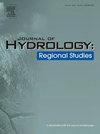Fifty years marshland changes in a large floodplain lake: Natural driving or human impact?
IF 4.7
2区 地球科学
Q1 WATER RESOURCES
引用次数: 0
Abstract
Study region: Poyang Lake, the largest freshwater floodplain lake in China. Study focus: Marshlands in a floodplain, as the typical natural wetland offering vital habitats for various organisms, are sensitive to environmental changes. The spatiotemporal changes of marshlands were investigated and their driving forces from both natural factors and human activities were discussed. The remote sensing image data from 1973 to 2022 was adopted to explore the long-term changes of marshlands exposed in dry season. New hydrological insights for the region: Over the past fifty years, the total area of marshlands in Poyang Lake is around 2540–2718 km2 and has undergone substantial changes. It follows the bell-shaped curve pattern with continuous rise since 1970s and reach the maximum at the end of 20 century and then fluctuating decline. Different evolutionary patterns were identified in different lake regions owing to the combination of human activities and natural processes. The expanding marshlands mainly concentrate in the central lake, while the significant losses of marshlands are observed in the northern lake(By sand mining and dyke constructions). In the southern lake, sediment input from inflow rivers deposited naturally in the river mouth elevated the lake bed and lead to delta expansion(A 3.1 km expansion has been observed). The complex geomorphological processes and fishery activities also create the dish-shaped internal sub-lakes in marshlands.
一个大型洪泛平原湖五十年来的沼泽地变化:自然驱动还是人为影响?
研究区域:鄱阳湖:中国最大的淡水洪泛平原湖泊。研究重点:洪泛区沼泽地是典型的天然湿地,是各种生物的重要栖息地,对环境变化十分敏感。本研究对沼泽地的时空变化进行了研究,并探讨了自然因素和人类活动对沼泽地变化的影响。采用 1973 年至 2022 年的遥感图像数据,探讨了旱季沼泽地的长期变化。对该地区水文的新认识:近五十年来,鄱阳湖沼泽地总面积约为 2540-2718 平方公里,发生了巨大变化。鄱阳湖沼泽地面积呈钟形曲线变化,自 20 世纪 70 年代以来持续上升,20 世纪末达到最大值,随后波动下降。在人类活动和自然过程的共同作用下,不同湖区呈现出不同的演变模式。沼泽地的扩大主要集中在中部湖区,而沼泽地的显著减少则出现在北部湖区(由于采砂和堤坝建设)。在南部湖泊,流入河流的泥沙在河口自然沉积,抬高了湖床,导致三角洲扩大(已观察到扩大了 3.1 公里)。复杂的地貌过程和渔业活动也在沼泽地中形成了碟形的内部子湖。
本文章由计算机程序翻译,如有差异,请以英文原文为准。
求助全文
约1分钟内获得全文
求助全文
来源期刊

Journal of Hydrology-Regional Studies
Earth and Planetary Sciences-Earth and Planetary Sciences (miscellaneous)
CiteScore
6.70
自引率
8.50%
发文量
284
审稿时长
60 days
期刊介绍:
Journal of Hydrology: Regional Studies publishes original research papers enhancing the science of hydrology and aiming at region-specific problems, past and future conditions, analysis, review and solutions. The journal particularly welcomes research papers that deliver new insights into region-specific hydrological processes and responses to changing conditions, as well as contributions that incorporate interdisciplinarity and translational science.
 求助内容:
求助内容: 应助结果提醒方式:
应助结果提醒方式:


